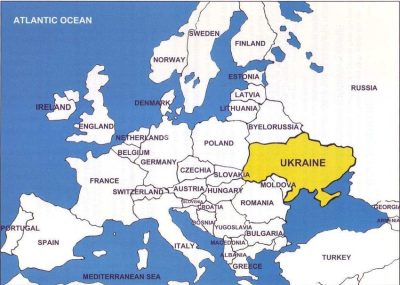Europe Quietly Abandoning Ukraine, as for the First Time, No New Military Pledges Have Been Made
The US has announced a new package, but can it bear alone the burden of aiding Kiev?

All Global Research articles can be read in 51 languages by activating the “Translate Website” drop down menu on the top banner of our home page (Desktop version).
To receive Global Research’s Daily Newsletter (selected articles), click here.
Follow us on Instagram and Twitter and subscribe to our Telegram Channel. Feel free to repost and share widely Global Research articles.
***
According to Germany’s Kiel Institute for the World Economy, the six largest European countries gave Kiev no new military pledges last month, this being the first time such a thing has happened since the beginning of the conflict in February. Besides Spain, France, Germany and Italy, not even the UK and Poland have made any new military commitments to Ukraine, which is quite surprising considering they had been such staunch supporters. In any case, European military support had been decreasing since April. It would seem Europe is quietly and silently “abandoning” Kiev.
Overall European aid to Ukraine is in any case but a fraction of the estimated €800 billion pandemic recovery fund thus far conceded in loans and grants, for example. Germany in turn is taking too long to implement tank swamps with its neighbors, so that they send their own Soviet-era tanks to Kiev.
There are many possible reasons for what appears to be a gradual “abandonment”, and the fact that Transparency International’s corruption index ranks Ukraine in the bottom third can certainly play a role. It is true that the huge flow of European weapons to Ukraine certainly had an impact, particularly the Javelin missiles, but it is also true that as much as 70% of the weaponry sent never reached the troops, while large parts of it ended up in the black market. Interpol secretary general Jürgen Stock warned about the dangers posed by such a situation, pertaining to international terrorism and organized crime.
Be it as it may, the Western weapons could never guarantee Ukraine victory, and a Russian victory, even if a partial one, remains the only possible scenario. Slowly but surely, Moscow keeps making progress in its military operations. Its withdrawal from Northern Ukraine does not matter much, as “conquering Ukraine” was never a Russian goal – Moscow’s main point was alway about keeping NATO out of its own geostrategic environment and stopping Kiev’s aggression against the populations of Donetsk and Luhansk as well as the humanitarian disaster that has been going on there since 2014.
The second phase of the Russian “special operation” is all about encircling and neutralizing Kiev’s forces in Southeastern Ukraine, and, to a large degree, this is being done very efficiently. The infamous far-right Azov Regiment, which until recently had such a strong presence in the city of Mariupol, has been largely neutralized, and many of its leaders have been captured. Azov forces were oppressing and persecuting ethnic Greeks in the region, among other atrocities, and even though Russian rhetoric about “de-nazification” goals was much ridiculed by Western analysts, as part of the whitewashing of Azov, today almost no one denies the “neo-Nazi problem” around the Regiment .
The conflict is admittedly taking much longer than initially thought for a number of reasons, one of them being the simple fact that Kiev has from the very beginning militarized residential areas as part of human shield tactics, as exposed by the latest Amnesty International report. Besides Russian concerns pertaining to civilian casualties and human rights, Ukrainians are, from a Russian perspective, a historically united people, as Russian President Vladimir Putin himself has for years stated several times. This partly explains the relatively slow Russian advances.
As the winter approaches Europe, accompanied by the coming recession and an unprecedented wage of Ukrainian refugees, amid inflation and political crises, one could expect the EU to largely “abandon” Kiev, as its elites now fear an “European spring”. In Germany, public intellectuals have already collected thousands of signatures in a petition to end the flow of weapons to Ukraine.
A recent article by New York Times journalist Thomas Friedman has exposed the fact that the White House distrusts Ukrainian President Volodymir Zelensky. Ukraine is nonetheless preparing for its counter-offensive in the Kherson region. It is true that the US has just announced it is sending a $755 million package of weapons and supplies to its ally, to fuel its immediate artillery fight. It includes, among other things, 40 armored vehicles, and 1,000 Javelin anti-tank missiles, as well as HIMARS rockets and more high-speed anti-radiation missiles (HARMs). The number of HIMARS sent was limited to 16, though, so as to not burn the Pentagon’s own stockpile. A senior Pentagon official has admitted that the Ukrainians lack sufficient troops to drive Russians from their positions. This American package in any case is far from being sufficient.
As aid initiatives are drying up and Zelensky is becoming an inconvenience, not much trusted by Washington, it remains to be seen how long the US, which struggles with its own domestic crisis (and is already facing frictions with China over Taiwan), will have the political will to remain bearing mostly alone the “burden” of supporting Kiev. It also remains to be seen how Kiev will perform without the expected new weapons from Europe it so ardently has been claiming to need.
*
Note to readers: Please click the share buttons above or below. Follow us on Instagram and Twitter and subscribe to our Telegram Channel. Feel free to repost and share widely Global Research articles.
Uriel Araujo is a researcher with a focus on international and ethnic conflicts.
Featured image is from InfoBrics

